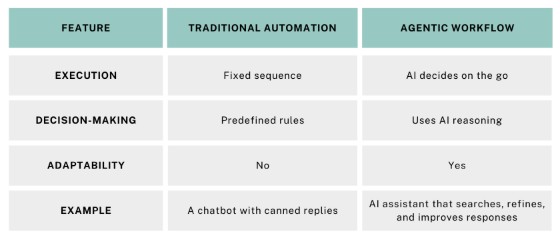The rise of large language models (LLMs) has unlocked a new paradigm in automation: agentic workflows. Unlike traditional automation, which follows predefined sequences, agentic workflows introduce decision-making, adaptability, and iterative problem-solving into AI-driven systems.
What Are Agentic Workflows?
An agentic workflow is an AI-driven process where agents make autonomous decisions, adapt to new information, and iteratively refine their actions. These workflows leverage LLMs, API calls, memory, and environment interactions to execute tasks dynamically.
Key Features:
- Autonomy: Agents make decisions based on evolving inputs.
- Context awareness: LLMs leverage memory (e.g., vector stores) to track and refine actions.
- Tool usage: Agents can invoke external APIs, search the web, or manipulate databases.
- Iterative refinement: Agents assess their outputs and retry tasks when necessary.
Example: Traditional vs. Agentic Workflow

Building an Agentic Workflow in AI
To illustrate LLM agentic workflows, let’s build a simple AI agent that:
- Receives a query
- Searches online for information
- Summarizes the results
- Refines its answer iteratively
We’ll use LangChain, a popular library for building LLM-driven agents.
Installation:
pip install langchain openai google-search-results
Step 1: Initialize the LLM Agent
from langchain.llms import OpenAI
llm = OpenAI(model_name="gpt-4", temperature=0.7)- The temperature parameter controls creativity (higher = more creative).
- gpt-4 is used for reasoning capabilities.
Step 2: Add a Search Tool
To enable real-world information retrieval, we integrate SerpAPI for web searches.
from langchain.tools import Tool
from langchain.utilities import SerpAPIWrapper
search = SerpAPIWrapper()
search_tool = Tool(name="Google Search", func=search.run, description="Fetches web results")Step 3: Define the Agentic Workflow
The agent should:
- Process a query
- Search online for data
- Summarize findings
- Refine its response iteratively
from langchain.agents import initialize_agent, AgentType
from langchain.memory import ConversationBufferMemory
memory = ConversationBufferMemory(memory_key="history", return_messages=True)
agent = initialize_agent(
tools=[search_tool],
llm=llm,
agent=AgentType.ZERO_SHOT_REACT_DESCRIPTION,
verbose=True,
memory=memory
)
response = agent.run("What are the latest trends in agentic workflows?")
print(response)What Happens in This Code?
In the last step, we created an AI agent using LangChain that can search the web and summarize results. Let’s break down how it works:
- The user asks a question → (e.g., “What are the latest trends in agentic workflows?”)
- The agent decides how to answer → It uses the Google Search tool.
- It searches the web → The agent fetches real-time information from search results.
- It summarizes the findings → Using GPT-4, it processes the data and creates a human-readable response.
- It remembers past interactions → Memory helps the agent keep track of conversations and improve future responses.
This makes our workflow agentic. Instead of following a fixed script, the AI thinks, searches, and dynamically improves its output.
Enhancing the Agentic Workflow
Agentic workflows are powerful when combined with feedback loops and self-refinement mechanisms.
1. Iterative Refinement
Agents should evaluate their own responses and improve them over multiple iterations.
def refine_answer(query):
for _ in range(3): # Iterative improvement
response = agent.run(query)
print("Refined Answer:", response)
refine_answer("Explain agentic workflows in AI with examples")2. Multi-Agent Collaboration
Instead of a single agent, multiple agents can collaborate—one searches, another summarizes, and another validates.
from langchain.agents import AgentExecutor
search_agent = initialize_agent([search_tool], llm, agent=AgentType.ZERO_SHOT_REACT_DESCRIPTION, verbose=True)
summary_agent = initialize_agent([], llm, agent=AgentType.ZERO_SHOT_REACT_DESCRIPTION, verbose=True)
executor = AgentExecutor(agents=[search_agent, summary_agent], verbose=True)
result = executor.run("Summarize agentic workflows with real-world applications")
print(result)3. Memory Persistence
For long-term interactions, agents can store context in a vector database (e.g., FAISS, Pinecone).
from langchain.vectorstores import FAISS
from langchain.embeddings import OpenAIEmbeddings
embeddings = OpenAIEmbeddings()
vector_db = FAISS(embedding_function=embeddings)
memory = ConversationBufferMemory(memory_key="chat_history", return_messages=True, vectorstore=vector_db)This allows the agent to remember previous queries and improve over time.
Applications of Agentic Workflows
Agentic workflows are transforming multiple industries:
1. AI Research & Writing
- Automating research synthesis.
- AI-assisted code explanations.
- Writing AI-generated reports.
2. Enterprise AI Agents
- Customer support bots: Dynamic problem-solving assistants.
- Compliance monitoring: AI agents ensure regulatory adherence.
3. Data & Security
- Cybersecurity threat analysis: Self-improving security assessments.
- Automated penetration testing: AI-driven security probing.
4. Software Development
- Code review and debugging automation.
- AI pair programming with agentic coding capabilities.
The Future of Agentic Workflows
The field of LLM agentic workflows is evolving rapidly, with key advancements such as:
- Multi-modal agents: LLMs that process text, images, and speech.
- AutoGPT & BabyAGI: Autonomous agents capable of complex goal execution.
- Self-improving AI: Agents that continuously learn from past interactions.
Conclusion
Agentic workflows mark a significant leap in AI autonomy, enabling dynamic, decision-driven automation. With memory, tool usage, and iterative refinement, these workflows enhance LLM capabilities beyond static prompting.
